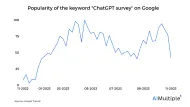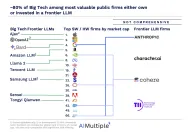Top 6 Use Cases of Generative AI in Education in 2024
Due to the COVID-19 pandemic, the use of digital technologies to enhance education has significantly increased as many students around the world have had to shift to online learning. For example, investment in education for adopting innovative technologies increased from $7 billion to $20 billion during the pandemic as trends suggest. However, digital technologies also have the potential to transform the education experience in other ways beyond just online classes. The application of generative AI in education is an example to this.
Generative AI is a digital technology that can quickly create new and realistic visual, textual, and animated content. In other articles, we investigated its use cases in different sectors, such as healthcare and banking. While other technologies like conversational AI and robotic process automation (RPA) are implemented in education, generative AI is not properly implemented in education. Despite this, it has potential use cases for improving it. This article explains the top 6 potential ways to use generative AI in education.
1. Personalized Lessons
Personalized lesson plans are a powerful way to ensure that students receive the most effective education tailored specifically to their needs and interests. These lesson plans can be generated by using AI-powered algorithms to analyze student data, such as:
- Their past performance
- Their skills
- And any feedback they might have given regarding content
AI-based systems can leverage such information to generate customized curriculum that is more likely to engage each student and help them reach their potential. This can be important for children with learning disabilities or disorders.
For example, Speechify is a generative AI-driven tool. It offers text-to-speech or speech-to-text generations on desktops or on online use.1 This kind of generative AI tools in education are especially useful for children with learning disabilities such as dyslexia or ADHD. When a child suffers from a lack of concentration due to such disorders, it can be harder to follow course contents via reading. However with such tools, they can generate texts into speech notes when they are bored.
2. Course Design
Generative AI tools can help design and organize course materials, including syllabi, lesson plans, and assessments. They can also personalize course material based on students’ knowledge gaps, skills and learning styles, such as practice problems or interactive exercises.
Generative AI can create simulations and virtual environments once paired with other technologies, such as virtual reality. Consequently, it offers more engagement and interactive courses, improving students’ learning experience.
For example, a generative AI system could create a virtual laboratory setting where students can conduct experiments, observe the results, and make predictions based on their observations.
3. Content Creation for Courses
Generative AI can assist in creating new teaching materials, such as questions for quizzes and exercises or explanations and summaries of concepts. This can be especially useful for teachers who need to create a large amount and a variety of content for their classes. By using AI, it is possible to create modified or brand-new content from the original content.
Furthermore, generative AI can facilitate generating additional materials to supplement the main course materials, such as:
- Reading lists
- Study guides
- Discussion questions
- Flashcards
- Summaries.
Also, AI can generate scripts for video lectures or podcasts, streamlining multimedia content creation for online courses. Image generation is another important ability of generative AI for education. Teachers may want to generate images with specific modifications that respond to particular course needs.
For example, NOLEJ offers an e-learning capsule that is AI generated in only 3 minutes. This capsule provides an interactive video, glossary, practice, and summary for a target topic (see Figure 1 below).2
Figure 1. An example of AI-generated course content. (Source: NOLEJ)
More established companies are using AI to generate content that supports their main products. For instance, Duolingo, a language learning platform, uses GPT-3 to correct French grammar and create items for their English test. The company concludes that with the implementation of GPT-3, second language writing skills of customers are increased.3
4. Data Privacy Protection for Analytical Models
One advantage of using generative AI to create training data sets is that it can help protect student privacy. A data breach or hacking incident can reveal real-world data containing personal information about school age children.
Using synthetic data, which is created by AI models that have learned from real-world data, can provide anonymity and protect students’ personal information. Synthetic data sets produced by generative models are effective and useful for training other algorithms, while being secure and safe to use.
For more on how generated synthetic data enables data privacy, you can check out these articles:
- https://research.aimultiple.com/synthetic-data-vs-real-data/
- https://research.aimultiple.com/synthetic-data-vs-data-masking/
5. Restoring Old Learning Materials
Generative AI can improve the quality of outdated or low-quality learning materials, such as historical documents, photographs, and films. By using AI to enhance the resolution of these materials, they can be brought up to modern standards and be more engaging for students who are used to high-quality media.
These updates can also make it easier for students to read, analyze, and understand the materials, leading to a deeper understanding of the content and, ultimately, better learning outcomes.
Using a version of generative AI, Generative Adversarial Networks (GANs), it is possible to restore low-quality images and remove simple watermarks. In Figure 2 below, you can see a prototype for image restoration via GANs. Such image restoration can be adapted to educational materials. For example, in art and design schools, restoring old images would provide the detection of important details of artworks. Also in history classes and research, scanning and restoring old documents can be facilitated.

Figure 2. Image restoration with GANs. (Source: Towards Data Science)
6. Tutoring
Another use case of generative AI is to provide tutoring. Generative AI can be used to create virtual tutoring environments, where students can interact with a virtual tutor and receive real-time feedback and support. This can be especially helpful for students who may not have access to in-person tutoring.
According to academic studies, private tutoring children with severe reading difficulty improved their reading skills by 50% in a year.4 However, providing tutoring to all students can be a challenge. Generative AI can tackle this issue by creating virtual tutoring environments. In these environments, students can interact with a virtual tutor and receive feedback and support in real-time. This can be especially helpful for students who may not have access to in-person tutoring.
For example, TutorAI is trying to implement this kind of use of generative AI in education. It offers an educational platform that generates interactive content on a variety of topics.5
Another generative AI work for teaching purposes can be the implementation of chatbots for tutoring. Chatbot Life’s 2019 chatbot report shows that education is the third biggest industry benefiting from chatbots.6 Check out our conversational AI in education article and learn the top use cases.
Lately, Chat GPT from OpenAI stormed the internet with its ability to engage in highly personalized conversations and definitive answers. It can answer course-related questions from a variety of domains, and can even write essays on the target topic.
On the other hand, implementing generative AI-based chatbots specified and regulated for educational purposes is a future plan. However, it offers potential uses and benefits:
- One potential use would be to provide around-the-clock support to students and their parents, including help with homework.
- Generative chatbots can also assist with administrative tasks, such as answering student or parent questions, freeing up time for educators to focus on other tasks, such as grading and lesson planning.
- The flexibility and natural feeling of generative chatbots make them useful in educational settings, particularly with elementary and middle school children.
Challenges of generative AI in education
Although generative AI has a lot of potential to improve educational practices, it may also pose some potential challenges. These can be shortly listed as:
- Biases in educational materials
- False or inaccurate information
- Abuse of it for self interest
- Unemployment risks for some teachers or other education professionals
For a detailed discussion on the ethical challenges of generative AI, you can check our article.
For more on generative AI
To explore more about generative AI, you can check our other articles:
- https://research.aimultiple.com/generative-ai-applications/
- https://research.aimultiple.com/ai-text-generation/
- https://research.aimultiple.com/stability-ai/
Discover the top generative AI tools from our detailed list sorted by category:
If you have questions regarding generative AI, feel free to reach out:
External Links
- 1. “How text to speech helps an Individualized Education Program.” Speechify. Accessed 25 December 2022.
- 2. Nolej. Accessed 16 January 2023.
- 3. “OpenAI – developing next-gen AI tools for the good of humanity. – Digital Innovation and Transformation.” HBS Digital Initiative, 18 April 2022. Accessed 25 December 2022.
- 4. “Evidence That Tutoring Works.” GovInfo. Accessed 3 January 2024.
- 5. “Learn anything“, TutorAI. Accessed 16 January 2023.
- 6. “Chatbot 2019 Trends and Stats with Insider Reports | by Aslam Abbas.” Chatbots Life. Accessed 16 January 2023.

Cem has been the principal analyst at AIMultiple since 2017. AIMultiple informs hundreds of thousands of businesses (as per similarWeb) including 60% of Fortune 500 every month.
Cem's work has been cited by leading global publications including Business Insider, Forbes, Washington Post, global firms like Deloitte, HPE, NGOs like World Economic Forum and supranational organizations like European Commission. You can see more reputable companies and media that referenced AIMultiple.
Throughout his career, Cem served as a tech consultant, tech buyer and tech entrepreneur. He advised businesses on their enterprise software, automation, cloud, AI / ML and other technology related decisions at McKinsey & Company and Altman Solon for more than a decade. He also published a McKinsey report on digitalization.
He led technology strategy and procurement of a telco while reporting to the CEO. He has also led commercial growth of deep tech company Hypatos that reached a 7 digit annual recurring revenue and a 9 digit valuation from 0 within 2 years. Cem's work in Hypatos was covered by leading technology publications like TechCrunch and Business Insider.
Cem regularly speaks at international technology conferences. He graduated from Bogazici University as a computer engineer and holds an MBA from Columbia Business School.
To stay up-to-date on B2B tech & accelerate your enterprise:
Follow on

Comments
Your email address will not be published. All fields are required.